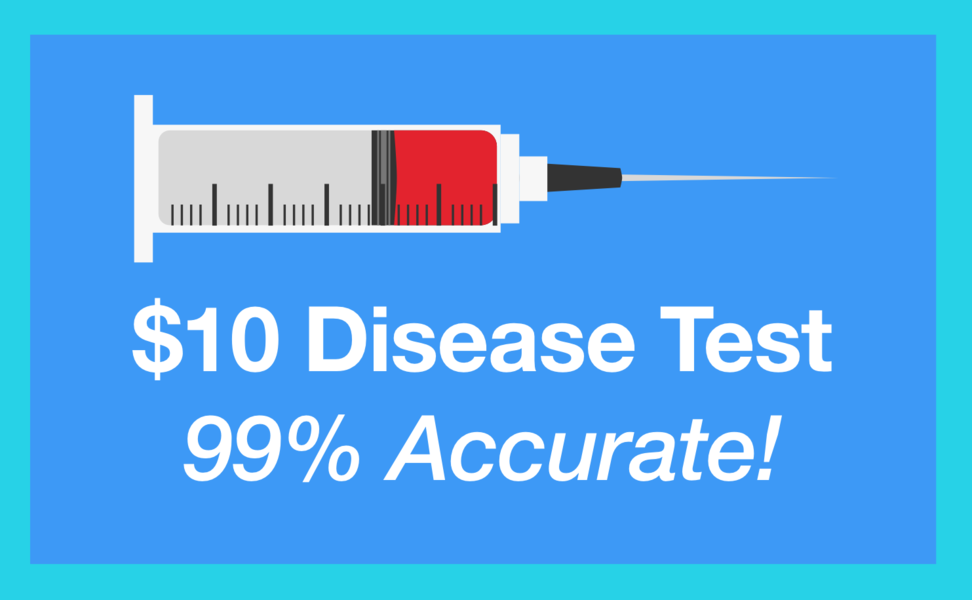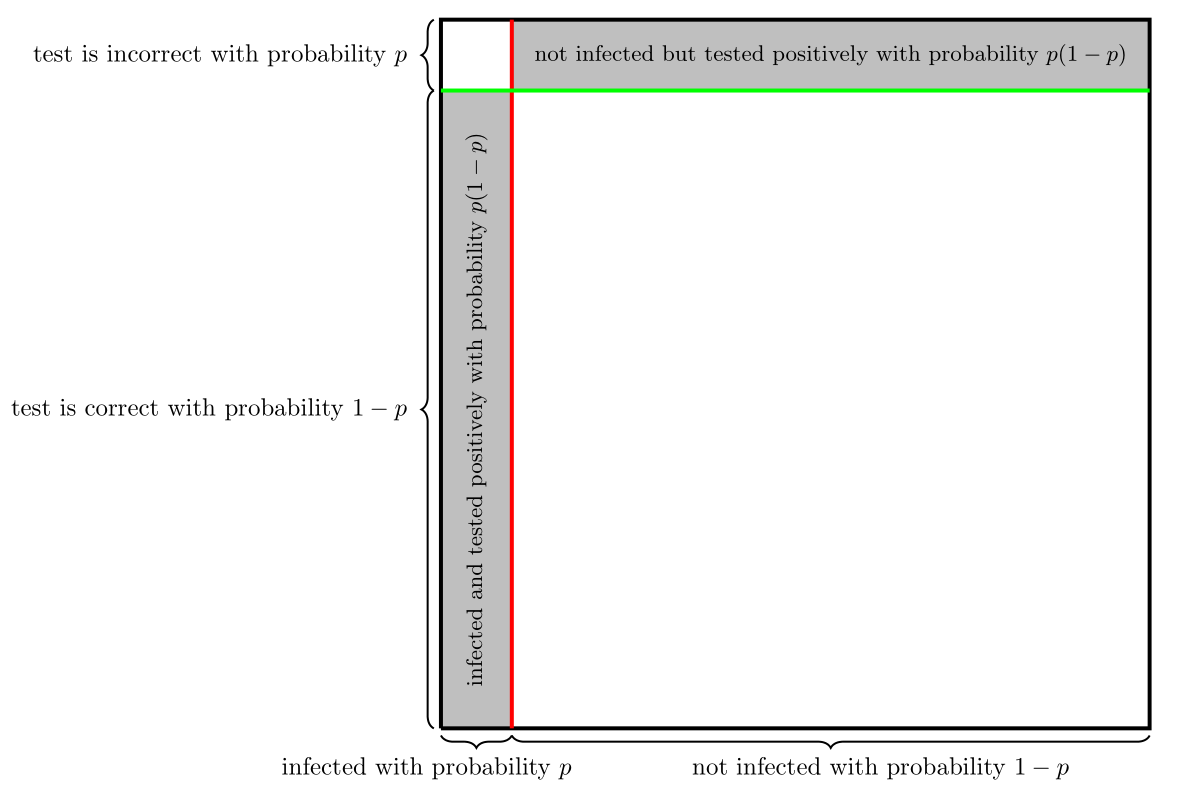Disease Test

A disease test is advertised as being 99% accurate: if you have the disease, you will test positive 99% of the time, and if you don't have the disease, you will test negative 99% of the time.
If 1% of all people have this disease and you test positive, what is the probability that you actually have the disease?
This section requires Javascript.
You are seeing this because something didn't load right. We suggest you, (a) try
refreshing the page, (b) enabling javascript if it is disabled on your browser and,
finally, (c)
loading the
non-javascript version of this page
. We're sorry about the hassle.
6 solutions
(You either don't have the disease and tested incorrectly) OR ( you don't have the disease and tested incorrectly) they both are essentially same statement, why are you adding this twice.
Do you mean to say: Since you test positive (You either have disease and tested correctly) OR ( You don't have the disease and tested incorrectly)
in which case it would be:
(1% X 99%) + (99% X 1%) = 2 X 99%. Thus 50% :)
This is going to sound stupid, but why is it that when I put the equation above in a calculator, it gave me one percent?
what is the probability one has the disease if they go for another test?
If Im not mistaken there is a typo in your solution. It should be a multiply sign at the bottom not an add. i.e. 99%*1%
d: having disease pos/neg:test result ^:not
p(d)=0.1 => p(^d)=0.9 p(pos|d)=0.99 => p(^pos|d)=0.01 p(neg|^d)=0.99 => p(pos|^d)=0.01
Bayes Theorem: p(d|pos)=p(pos|d) p(d)/p(pos) when p(pos)=p(d|pos)+p(^d|pos)=0.99 0.1 + 0.01 0.9=0.108 then p(d|pos)=(0.99 0.1)/0.108=0.917
Is this understanding of Bayes theorem right?
Isn't the denominator supposed to be 1% * 99% + 99% * 1% , not 1% * 99% + 99% + 1%
Log in to reply
You are right, the denominator should be: 1% * 99% + 99% * 1%. That means the equation expression becomes: (99/10000)/(198/10000) = 50%.
That should be little less than 50%
There is a certain symmetry which is worth mentioning here. From the figure below it is obvious that if the probability of being infected and tested incorrectly are the same (no matter how small they are), then the probability of being infected provided that tested positively is always 50%. From this figure it is also obvious that in order to increase this probability (so that the test would be actually useful), we have to increase the reliability of our test.

Very nice visualization
P(A) = probability of testing +ve P(B) = probability of disease
Given, P(B) = 1/100 P(A|B) = 99/100 (Probability that a person has disease and tests positive)
We have to find P(B|A) which is probability that you have a disease given you test positive
Using Bayes: P(B|A) = P(B) x P(A|B) /P(A) -----> Equation 1
we know P(B) and P(A|B) Only have to find P(A) Let C be event of probability of no disease. So, P(C) = 1- 1/100 = 99/100 and given in the problem is the fact that in case of no disease, the probability is 99/100 times accurate.. so 99/100 times it will correctly classify people with no disease as having no disease but incorrectly classify 1/100 times that people with no disease have disease. Let this be called P(D)
Now, probability of testing positive P(A) = probability of testing positive when when it is true + probability of testing positive when not true = 1/100 x 99/100 ( this is P(B) x P(A|B) ) + 99/100 x 1/100 (This is P(C) x P(D) ) = 2x 99/10000
substitute in Equation 1 above and solve.. answer= 1/2 or 50%
(Chances for an incorrect result) * healthy people = 1% * 99 = 0.99
(Chances for correct result) * ill people = 99% * 1 = 0.99
Total positive results: 0.99 + 0.99 = 1.98
The probability for an ill person to test positive is:
(total ill persons) / (total positive tests): 1 . 9 8 0 . 9 9 =50%
did it somewhat mechanically and got it right - this is an eye-opener man!
There is a typo in Eli Ross's solution. Denomination should have a multiplication sign instead of a plus sign between the latter 99% and 1%.
CURRENTLY: ...+ 99% + 1%
SHOULD BE: ...+ 99% × 1%
You either don't have the disease and tested incorrectly ( probability), or you don't have the disease and tested incorrectly ( probability). By Bayes' Theorem, the probability you have the disease is
My solution: (sensitivity * probability of being infected)/((probability of being infected) sensitivity) (probability of not being infected)*(1- sensitivity)) where sensitivity is total cases when I was tested positive and I was actually infected. Hope this helps.
why is it not : (0.01 x 0.99) / (0.01x0.99+ 0.01x 0.01) = 0.99 (99%) ?? I'm just referring to the bayes' theorem.
You either don't have the disease and tested incorrectly ( 1 % × 9 9 % probability), or you don't have the disease and tested incorrectly ( 9 9 % × 1 % probability). By Bayes' Theorem, the probability you have the disease is 1 % × 9 9 % + 9 9 % + 1 % 1 % × 9 9 % = 5 0 % .